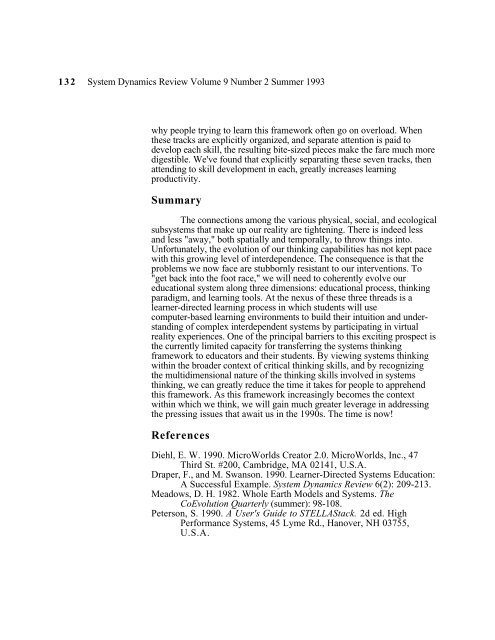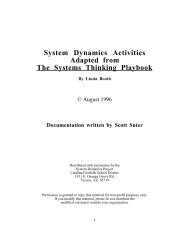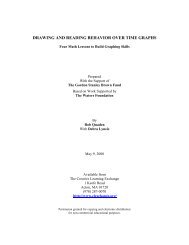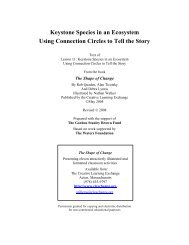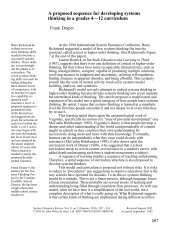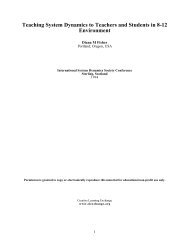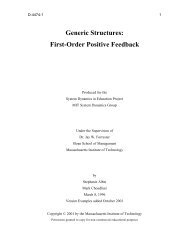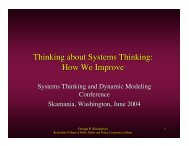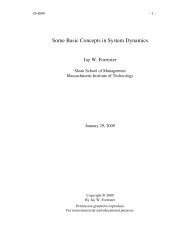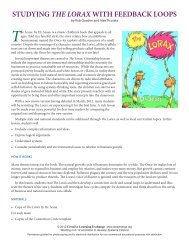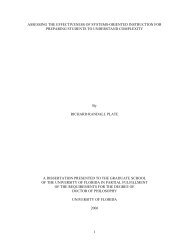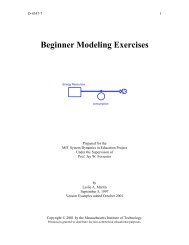Systems thinking: critical thinking skills for the 1990s and beyond
Systems thinking: critical thinking skills for the 1990s and beyond
Systems thinking: critical thinking skills for the 1990s and beyond
- No tags were found...
You also want an ePaper? Increase the reach of your titles
YUMPU automatically turns print PDFs into web optimized ePapers that Google loves.
132 System Dynamics Review Volume 9 Number 2 Summer 1993why people trying to learn this framework often go on overload. When<strong>the</strong>se tracks are explicitly organized, <strong>and</strong> separate attention is paid todevelop each skill, <strong>the</strong> resulting bite-sized pieces make <strong>the</strong> fare much moredigestible. We've found that explicitly separating <strong>the</strong>se seven tracks, <strong>the</strong>nattending to skill development in each, greatly increases learningproductivity.SummaryThe connections among <strong>the</strong> various physical, social, <strong>and</strong> ecologicalsubsystems that make up our reality are tightening. There is indeed less<strong>and</strong> less "away," both spatially <strong>and</strong> temporally, to throw things into.Un<strong>for</strong>tunately, <strong>the</strong> evolution of our <strong>thinking</strong> capabilities has not kept pacewith this growing level of interdependence. The consequence is that <strong>the</strong>problems we now face are stubbornly resistant to our interventions. To"get back into <strong>the</strong> foot race," we will need to coherently evolve oureducational system along three dimensions: educational process, <strong>thinking</strong>paradigm, <strong>and</strong> learning tools. At <strong>the</strong> nexus of <strong>the</strong>se three threads is alearner-directed learning process in which students will usecomputer-based learning environments to build <strong>the</strong>ir intuition <strong>and</strong> underst<strong>and</strong>ingof complex interdependent systems by participating in virtualreality experiences. One of <strong>the</strong> principal barriers to this exciting prospect is<strong>the</strong> currently limited capacity <strong>for</strong> transferring <strong>the</strong> systems <strong>thinking</strong>framework to educators <strong>and</strong> <strong>the</strong>ir students. By viewing systems <strong>thinking</strong>within <strong>the</strong> broader context of <strong>critical</strong> <strong>thinking</strong> <strong>skills</strong>, <strong>and</strong> by recognizing<strong>the</strong> multidimensional nature of <strong>the</strong> <strong>thinking</strong> <strong>skills</strong> involved in systems<strong>thinking</strong>, we can greatly reduce <strong>the</strong> time it takes <strong>for</strong> people to apprehendthis framework. As this framework increasingly becomes <strong>the</strong> contextwithin which we think, we will gain much greater leverage in addressing<strong>the</strong> pressing issues that await us in <strong>the</strong> <strong>1990s</strong>. The time is now!ReferencesDiehl, E. W. 1990. MicroWorlds Creator 2.0. MicroWorlds, Inc., 47Third St. #200, Cambridge, MA 02141, U.S.A.Draper, F., <strong>and</strong> M. Swanson. 1990. Learner-Directed <strong>Systems</strong> Education:A Successful Example. System Dynamics Review 6(2): 209-213.Meadows, D. H. 1982. Whole Earth Models <strong>and</strong> <strong>Systems</strong>. TheCoEvolution Quarterly (summer): 98-108.Peterson, S. 1990. A User's Guide to STELLAStack. 2d ed. HighPer<strong>for</strong>mance <strong>Systems</strong>, 45 Lyme Rd., Hanover, NH 03755,U.S.A.


